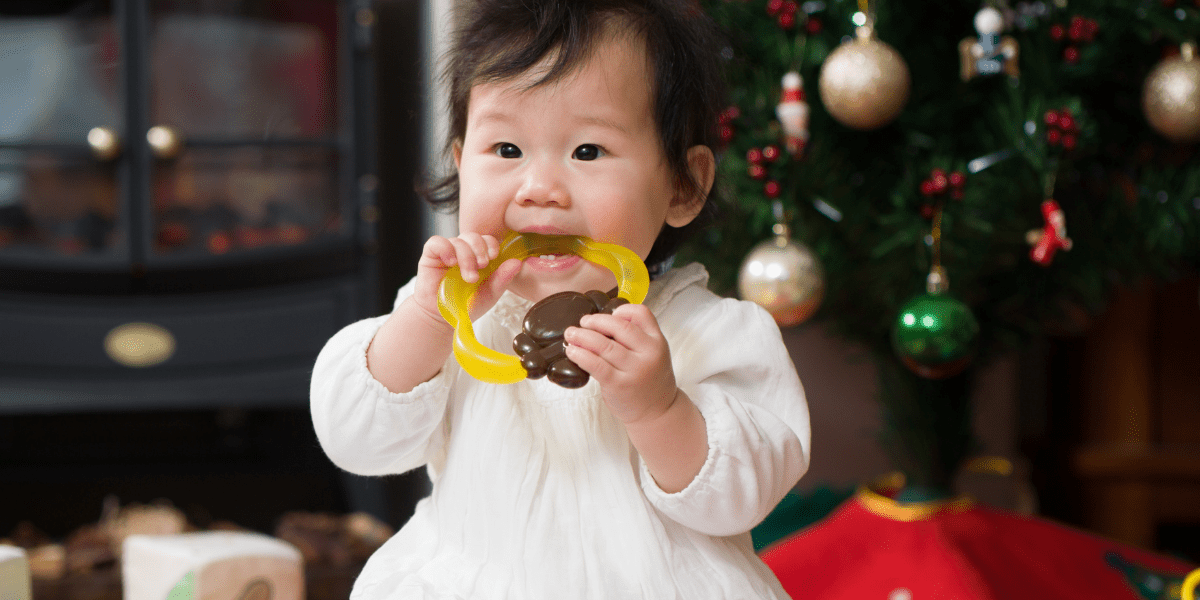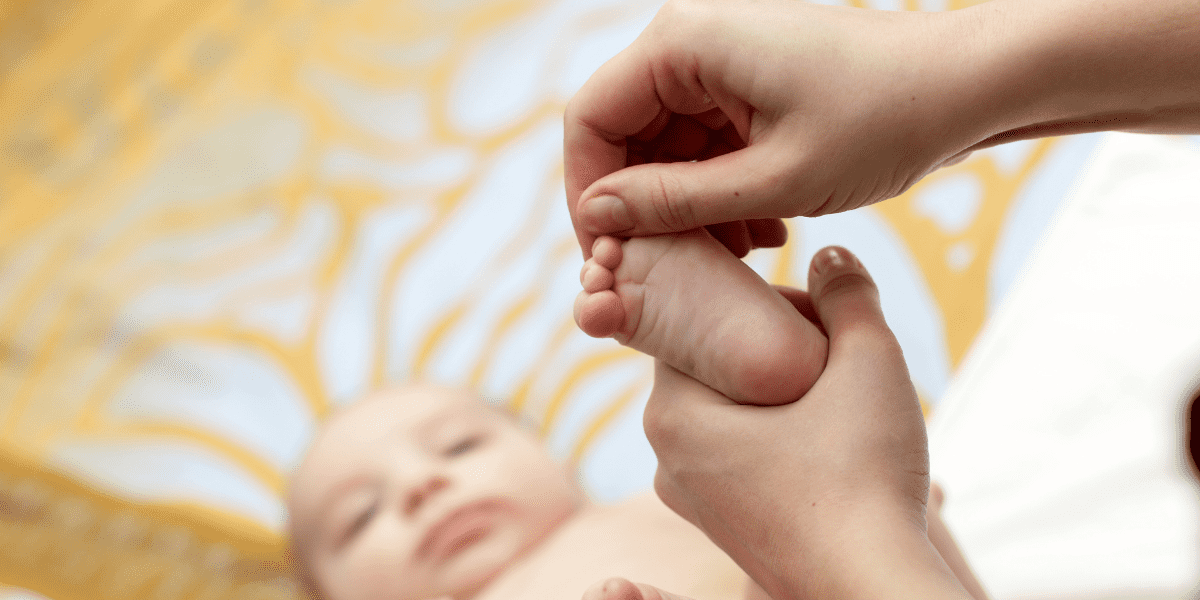One of the most challenging milestones a baby has to endure is teething.
Teething can start for a baby as early as 3 months old but typically begins between 4 – 6 months.
Symptoms of teething can present in the baby’s body a few days before the teeth cut through the gums.
These signs can include and are not limited to; a high temperature, a disinterest in food, an upset tummy, sore gums, and constant dribbling.
As an Amazon Associate, I earn from qualifying purchases. The links below may be affiliate links. Please read my disclosure policy for more information.
Along with a generally grisly attitude, you may also notice that your baby starts to look for things to chew on. This instinct to gnaw on everything they get their hands on is to add pressure to their swollen gums easing some of their discomforts.
It is at this point that you will benefit from introducing a teether.
Teethers or teething rings are a great tool for keeping your baby satisfied both at home and out and about during the teething stage.

In this day and age, there are thousands of teethers available on the market in hundreds of different designs.
Not only are they designed to relieve your baby’s pain during teething but they can help babies reach developmental milestones.
Aiding their ability to hold and shake an object as well as the hand-eye coordination needed to bring the toy to their mouth.
With so many on the market, it is hard to know which option is best and more importantly whether they are safe for your baby.
So let’s take a look at the risks and the alternative options available.
Are teethers safe for your baby?
Whilst the overall design of a teether poses no risks to young children, the materials they are made from can tell a different story.
Studies have found that, unfortunately, some of the mainstream toy manufacturers use chemicals on their teethers that pose a biological risk to babies.
Chemicals to look out for if you are buying from one of these big manufacturers include:
- PVC/ Vinyl – This is potentially the most harmful risk as PVC contains chemicals such as Chlorine. There is also the possibility it contains traces of lead and other heavy metals.
- Phthalates – These are not directly listed on toy packaging but are instead labeled as “fragrance” or “Parfum”. They are used to not only add scents to products but also make materials soft. They can be found in a lot of bath toys such as rubber ducks. Independent studies have found that phthalates have some estrogenic properties. These disrupt a child’s hormone balance.
- BPA – You may be familiar with this one and might have seen the sticker “BPA Free” on many toy packages. This has largely been ruled out of manufacturing, but not entirely. So it is an important one to be wary of. BPA is most commonly found in plastics that have a recycling label with ‘7’ on.
- Lead – As previously mentioned Lead can be found in PVC but also paints and varnishes used on toys.
- Latex – Latex has the risk of causing an allergic reaction in your baby so it is best to avoid it generally.
Whilst the above list seems scary enough to put you off buying toys for good.

When it comes to teethers there are several non-toxic options on the market to take your pick from.
These include:
100% Natural Rubber – Whilst it doesn’t sound like it should be, natural rubber is safe for babies. A favorite amongst parents is the Bunny teether available on Amazon. With a 4.5 star rating, it is easy to hold, easy to clean, and biodegradable.
Untreated Natural Wood – Wood teethers can be found in several designs and are a popular product on sites such as Etsy. They are mostly made from beechwood because it doesn’t splinter and has natural antibacterial properties. The majority of natural wood teethers are left untreated. If they are treated you should only buy those treated or polished using 100% beeswax.
Food-grade Silicone – When looking at silicone teethers you should only buy those that claim to be made from food-grade silicone. Which are 100% non-toxic for babies. If they are colored it should also state in the description that they are made using food-grade paint. As well as being available in the standard teething ring shape you can purchase these teethers in many forms. These include necklaces that you can wear which your baby can chew on whilst being held; dummy clips attached to your baby’s clothes and dribble bibs which have a silicone triangle on the end that babies can chew on whilst being worn.
Organic Cotton – Organic cotton can most commonly be found on beechwood teethers as an accessory. The two make the perfect combination. The hardwood can be chewed to apply pressure to the gums and the soft cotton can be frozen. This can then be sucked to soothe the gums or used to mop up the excess dribble.
When your baby first starts teething don’t feel as though you have to jump straight to your purse to find the solution.
We have a couple of mum-approved tricks you can use to help your little one out, using items you already have at home.
The frozen washcloth
It is a universally known fact that pain can be eased using either a cold or warm compress. This fact also applies to teething.
Take any clean fabric in your house (popular choices include muslin cloths, cotton flannels, bibs, etc). Wet this under cold sterile water and ring out so it is just damp, and put it in the freezer.
Your baby will find great comfort from sucking the cold water off and chewing on the frozen fabric. If you have natural wooden teethers you can also put these in the freezer for a few minutes and give them to your baby once cold.
The cold will numb their gums offering temporary relief.
If you have neither of these then opt to put their dummy/ pacifier in the freezer for the same effect.

Fruit or Milk Popsicles
Try freezing either your baby’s milk or your favorite pureed fruit or vegetable.
You can buy BPA-free silicone molds and sticks to make these mini popsicle treats.
You can also cut up fruits such as apple, mango, and cantaloupe into large chunks and freeze them for a few minutes.
These chilled chunky treats will keep your baby preoccupied as well as offer momentary relief for their gums as they chew them.
Offer a gum massage
Wash your hands, and gently push down on your baby’s gums. This pressure will counteract the pressure being made from their teeth pushing up through the gums and will feel good for your baby.
You can also try running your hand under cold water for a few minutes and allow your baby to gnaw on your finger.
Foot Massage
Reflexology is based on the idea that all body parts and systems are reflected on the feet.
It is believed that by applying gentle pressure to certain areas of the feet, you can offer relief for issues such as teething.
This is done by stimulating pain-relieving hormones. It is believed that pressure added to the toes can affect problems associated with the head and teeth.
A quick google search on reflexology for teething will give you access to diagrams and youtube videos that talk you through how to do it.
For a professional opinion contact a local reflexologist.

Chamomile Tea
Chamomile has been used as a natural remedy for alignments for thousands of years. This is because it contains an antioxidant called apigenin which induces sleep and even reduces anxiety.
More importantly for a case of teething, it has been known to reduce inflammation. There are several ways you can administer Chamomile to your baby.
You can dip your finger into the brewed tea and rub it on your baby’s gums; soak a clean cloth in it and let your baby suck it off or you can buy it in tablet form, crush it up and mix it into their food.
For an older baby, you can brew it in tea form, let it cool, and give it to them to drink directly.
Teething can be a very uncomfortable time for babies but it is important to remember it is an integral milestone in their development.
Whilst it begins typically around 4-6 months, it lasts between 25 – 33 months old. Not all babies experience pain when they are teething but if they do it will only last a couple of days until the teeth cut through the gums.

As a parent, it can be very disconcerting to see your little one suffering.
But with the help of natural teethers and tips and tricks passed down by other parents, you can feel confident in your ability to take some of that pain and discomfort away.
Remember, take a minute to read the labels on your products to eliminate the risk of buying anything containing harmful toxins. Instead, choose natural teethers made from wood, organic cotton, or natural rubbers.
Couple this with unlimited love and cuddles and your little one will be back to their happy self in no time – this time with a toothy grin to match!



